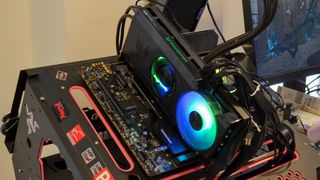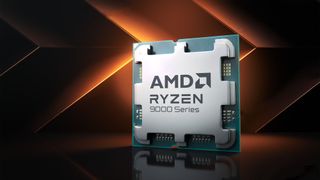From www.tomshardware.com
Tom’s Hardware Verdict
The XG27ACS delivers tremendous performance and color accuracy not just for the price but when compared to any monitor at any price. If you want better gaming, you’ll have to spend a lot more money.
Pros
- +
Sharp, bright and colorful image
- +
Perfect color accuracy out of the box
- +
Excellent HDR contrast
- +
Premium grade video processing with flexible options
- +
Solid build quality
Cons
- –
No speakers or USB ports
Why you can trust Tom’s Hardware Our expert reviewers spend hours testing and comparing products and services so you can choose the best for you. Find out more about how we test.
165 Hz 27-inch QHD gaming monitors have become a bread-and-butter category for players and users looking for the most bang for the buck regarding the best gaming monitors. With high performance, sharp imagery, and low prices, there are many choices, but the differences in quality are small.
If you’re willing to spend a bit extra, you can get a little more speed, 180 Hz, which is worthwhile for its smoother motion processing and slightly lower input lag. I’ve looked at many of these and here I have what might be the best example yet, Asus’ ROG Strix XG27ACS. It’s a 27-inch QHD IPS 16:9 flat panel with 180 Hz, Adaptive-Sync, HDR10, a wide gamut, and extremely accurate color for around $300. Let’s take a look.
Asus ROG Strix XG27ACS Specs
Swipe to scroll horizontally
| Panel Type / Backlight | IPS / W-LED, edge array |
| Screen Size / Aspect Ratio | 27 inches / 16:9 |
| Max Resolution and Refresh Rate | 2560×1440 @ 180 Hz |
| Row 3 – Cell 0 | FreeSync: 48-180 Hz |
| Row 4 – Cell 0 | G-Sync Certified |
| Native Color Depth and Gamut | 8-bit / DCI-P3 |
| Row 6 – Cell 0 | HDR10, DisplayHDR 400 |
| Response Time (GTG) | 1ms |
| Brightness (mfr) | 350 nits SDR |
| Row 9 – Cell 0 | 400 nits HDR |
| Contrast (mfr) | 1,000:1 |
| Speakers | None |
| Video Inputs | 1x DisplayPort 1.4 |
| Row 13 – Cell 0 | 1x HDMI 2.0 |
| Row 14 – Cell 0 | 1x USB-C |
| Audio | 3.5mm headphone output |
| USB 3.0 | None |
| Power Consumption | 22.7w, brightness @ 200 nits |
| Panel Dimensions WxHxD w/base | 25.3 x 15.3-19.9 x 8.6 inches (643 x 389-505 x 218mm) |
| Panel Thickness | 2.4 inches (61mm) |
| Bezel Width | Top/sides: 0.3 inch (8mm) |
| Row 21 – Cell 0 | Bottom: 0.8 inch (20mm) |
| Weight | 14.6 pounds (6.6kg) |
| Warranty | 3 years |
Asus’ ROG Strix line is known for good value, and the XG27ACS carries that mantra. It’s a Fast IPS panel with a one-millisecond gray-to-gray response time, 180 Hz, and certification for both G-Sync and FreeSync variable refresh rate technology. It’s one of the rare gaming monitors that allows Adaptive-Sync and ELMB (blur reduction) to operate simultaneously. Video processing is precise and flexible here, with fine overdrive control and smooth performance.
The XG27ACS is a wide-gamut screen with around 90% measured coverage of DCI-P3. That by itself isn’t a big deal; many monitors in this category boast the same. But Asus has really upped the ante with color accuracy. I found it measured spot on out of the box for grayscale, gamma, and gamut with no calibration required. It’s so close to perfect that I couldn’t make it any better with the included adjustment options.
There is plenty of light output available with a VESA DisplayHDR 400 certification and dynamic contrast for a native ratio of around 1,000:1 and almost 4,600:1 for HDR content. The picture is bright and colorful, with decent black levels and highlights that pop. 109ppi pixel density means a tight dot structure and excellent clarity. It also means you won’t need a premium video card to achieve fast and smooth frame rates. The 180 Hz is available without overclock.
The XG27ACS is well stocked with gaming features. There are aiming points, timers, frame rate counters, and many video processing options. In that regard, it is equal to any ROG Swift display. Some convenience items are left off the list though, like USB ports, LED lighting and internal speakers. There are just three video inputs, one each of DisplayPort, HDMI and USB-C. But in a cool touch, you get a slot for a smartphone in the base. That’s a first, in my experience. And there’s a threaded mount at the top of the stand for webcams or anything with a standard tripod bolt.
Considering the XG27ACS’s color accuracy and performance, it’s a bargain at $300. There are many monitors in this category but this one might be the best of them all.
Assembly and Accessories
The XG27ACS’s carton qualifies as a plain brown wrapper with minimal artwork to suggest its gaming intent. Blocks of crumbly foam protect the three main parts, panel, upright and base. A zippered pouch contains the cable bundle, which includes DisplayPort and IEC power. No tools are required for assembly.
Product 360

The XG27ACS sports a thin flush bezel of eight millimeters around the top and sides. The bottom trim is sculpted with a ROG logo at the center and measures 20mm wide. Controls are around the back right and consist of four large buttons and a joystick. A few thin lines are molded into the plastic in the back, along with a large ROG logo in one corner. You also get white ROG graphics on the upright above the hole for cable management. The base features a large slot for your phone and red trim around the upright’s attachment point.
The stand has full ergonomics with 4.7 inches (120mm) of height adjustment range, 45 degrees swivel, 5/20 degrees tilt, and 90-degree rotation for portrait mode in either direction. Movements are of equal quality to any premium display, including Asus’ ROG Swift models. Build quality is superb, and the XG27ACS is rugged enough for long-term use. Atop the stand is a tripod socket mount with a rubber pad suitable for webcams or anything else you might wish to attach to your monitor.
The input panel is adorned with just one of each video interface. The HDMI 2.0 port tops out at 144 Hz, while the DisplayPort 1.4 and USB-C run at the full 180 Hz. USB-C is only for video, it doesn’t support peripherals and there are no additional downstream ports. There are no internal speakers either, but you get a 3.5mm headphone jack.
OSD Features
Looking at the XG27ACS’s OSD, you’d think it is a premium gaming monitor. And given its features and performance, it is in every way except price.

The XG27ACS has one of the most flexible and comprehensive sets of video processing options I’ve ever seen. Variable OD is extremely precise and features 20 levels of overdrive. If you run at 180 fps, number 7 is the sweet spot between blur reduction and visible ghosting. ELMB (Extra Low Motion Blur) is the backlight strobe, and unlike most monitors, it can be used together with Adaptive-Sync/VRR. By selecting ELMB SYNC. You can also turn VRR off and have more control over ELMB with variable pulse width (Clarity Level) and which part of the screen gets more attention (Clarity Position). It works well once you dial it in. Clarity Level reduces blur at the expense of light output. The Position option lets you focus on the top, middle, or bottom of the screen.
GamePlus options are complete with fixed aiming points and a dynamic crosshair that changes color to remain in contrast with the background. You also get timers, a stopwatch, FPS counter, and display alignment marks.
There are nine total picture modes in the GameVisual menu. Racing is the default and best mode. It doesn’t require calibration, nor does it benefit from it. I was unable to make an improvement in any metric. Grayscale, gamma and color are completely free of visual errors. The Image menu has the usual brightness and contrast controls along with the three HDR modes that appear when an HDR10 signal is present. You can turn on the backlight controls in HDR mode if you find the image too bright.
The color menu has every calibration option including selectable color space. Hint: if you want sRGB, pick that mode from GameVisual. It’s perfectly accurate. I recommend leaving the Display Color Space option on Wide Gamut. If you want to tweak, there are color temp presets by Kelvin value plus RGB sliders. And there are six gamma presets too.
Two of the control keys can be programmed to different monitor functions like brightness, input select and others. You can also save settings to two separate memories using Customized Setting. In the final menu, you can reset everything to factory defaults.
Asus ROG Strix XG27ACS Calibration Settings
In the XG27ACS’s Racing mode, no calibration is required. You can tweak to your heart’s content, and I did just that, but for me, there was no visual or measured improvement. This monitor is spot-on from the factory. SDR content uses the full native color gamut when the Color Space option is set to Wide Gamut. If you want sRGB, it’s best to use that picture mode from the GameVisual menu. It is also without visual error. It retains access to the Brightness control, so you can equalize light output between modes if you wish. Below, I’ve provided the settings for commonly used peak white levels.
HDR signals get three additional picture modes. Gaming HDR is the default and best choice there. You can turn on access to the brightness slider if you find the image too bright, but this will affect the luminance tracking and reduce HDR impact. It’s definitely a personal preference option.
Swipe to scroll horizontally
| Picture Mode | Racing |
| Brightness 200 nits | 49 |
| Brightness 120 nits | 25 |
| Brightness 100 nits | 19 |
| Brightness 80 nits | 13 |
| Brightness 50 nits | 3 (min. 46 nits |
| Contrast | 80 |
| Gamma | 2.2 |
| Color Temp | 6500K |
Gaming and Hands-on
The XG27ACS punches well above its $300 price tag. It has superb video processing with so many flexible options that you are guaranteed to find a perfect balance between smoothness and response. If you can run at 180fps, the best choice is OD on 7 and Adaptive-Sync engaged. I used G-Sync without issue, driven by a GeForce RTX 4090. 180fps is no problem for this system but you can get there with a lesser video card if your budget dictates.
At frame rates below 150, the ELMB is a great option. You can run it along with Adaptive-Sync or turn VRR off and gain options for brightness/clarity and screen zone. For shooters, leaving the position on center screen makes the most sense because that is where the player’s focus is. Having this many choices can be confusing but it’s so much fun trying everything out. The XG27ACS can easily adapt to systems of any performance level from budget to high-end.
The image is stunning regardless of whether you’re playing SDR or HDR games. Color is so well balanced and saturated that you just gaze. Though there are only minor differences between most of the monitors in this category, the XG27ACS is clearly the best in terms of color accuracy, saturation and visual quality.
This quality carries over to workday tasks, which are easily accomplished thanks to the sharp image and vivid color. Word processors benefit from clear type and no obvious jaggies. 109ppi is enough pixel density to hide the dot structure. Yes, Ultra HD will be a bit better, but you won’t get that for $300.
I didn’t miss the USB ports or speakers here. While many monitors have these features, they do not impact their ability to play games or get work done. The XG27ACS has the added bonus of a phone slot in the base and a tripod mount atop the stand. You can install a very nice webcam or microphone. And the phone took a useful place right in front of me, below the screen. Honestly, I had never thought of this one but if more companies did this, it would be a good thing.
Takeaway: The XG27ACS is a $300 monitor that performs like a $600 display. Its color is incredibly accurate, with vivid saturation in both SDR and HDR modes. It has bright HDR with good black levels and bright highlights and more dynamic range than many VA panels. And it has video processing that rivals, and in most cases surpasses, the very best gaming monitors I’ve reviewed. Unless you spend significantly more money on a 240 Hz OLED, you won’t find much better, and certainly not for $300.
MORE: Best Gaming Monitors
MORE: How to Buy a PC Monitor
[ For more curated Computing news, check out the main news page here]
The post Asus ROG Strix XG27ACS QHD 180 Hz gaming monitor review: Exceptional accuracy and flexible performance | Tom’s Hardware first appeared on www.tomshardware.com















